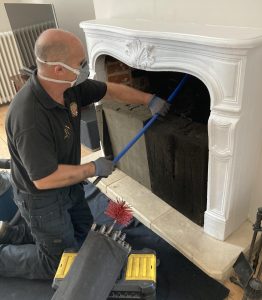
I have not previously written about actually doing the sweeping work before in my blog, I don’t know why, but thinking about it now, it seems to be a major omission on my part. Afterall chimney sweeping is what we do! So here is a little insight into the daily round!
The scene in the photo is of a job in Littlebury, where I’m manually sweeping a large opening brick lined chimney – Which is still quite a common occurrence in the sweeping sphere. To those noy initiated to the arts of chimney sweeping there are various different types of sweeping, and not all alleged chimney sweeps are familiar with the different kinds of chimney sweeping techniques and differing types of equipment. For example, power or rotary sweeping relies on the use of a drill to turn rod that click or button lock together and which turn very quickly – A variety of different sweeping heads can be used with power rods, including various nylon stranded heads, various metal cable/strands, brushes or even chains for cleaning tarry terracotta liners. Power sweeping is very effective for cleaning stubborn tar deposits, chimneys with tight turns, or stripping out bird’s nests. However, it should not be used on chimneys made of old soft red brick, old clay pargeted chimneys or brick chimneys that are in a poor state of repair, as it is far too vigorous a method of sweeping and would cause damage to the chimney. This said many sweeps that are out there in your area are only equipped and trained to use the power sweeping technique.
Another methos of sweeping involves the use of a German invented piece of equipment called a Viper. Vipers come in various sizes and like with power sweeping the equipment can be fitted with various different sizes and types of brushes. The viper is a long coil fitted tightly within a round cage, and secured with a brake, that a brush can be attached to the end of and is in essence, rods on a reel. It is the torque within the real that drives the brush up a chimney when the brake is released. The brush can be scrubbed up and down the chimney to effect cleaning. The viper is ideal for sweeping lined appliances, such as stoves and ranges. It does have a significant draw back in that it will only work on a chimney that is relatively straight throughout. This is because there is no way of turning the brush with a viper, so there is no way of getting it to negotiate chimney turns.
Having said all this, what is taking place in the photograph is an example of what we term manual sweeping, where rods and a brush are used to clean the chimney, just as in the days of Victorian chimney sweeps. The only difference today are that the rods are made of carbon fiber and not cane of wood. They do however screw together in the same old way. A particular technique has to be learnt by the sweep to perform manual sweeping, not only to ensure that the chimney is swept effectively, but also to make sure the rods and brush do not undo in the chimney. This involves constantly turning the rods clockwise whilst sweeping the chimney and by putting torque into the rods to prevent them undoing. Torque is achieved by bending each successive rods as they are added, up to the sweeps right shoulder and then twisting it clockwise from the shoulder as it is pushed up the chimney. When the top of the chimney is reached the whole process is reversed on the way down.
Here in the photograph, I’m using a large inglenook brush to sweep what is quite a large open chimney. For each sweep I lay out the equipment required in the same position on the dust sheets. I have the industrial hoover always to my left and my toolbox and rods or viper to my right. If using rods I always rest them on the tool box for ease of access, although I now use an open toolbox, not the one seen in the photo. And that is how I manually sweep an open fire chimney.


 My name is Paddy McKeown, I am a retired police officer (Detective Sergeant – Metropolitan Police), turned chimney sweep. I have completed training with ‘The Guild of Master Chimney Sweeps’, and Rod Tech UK (Power Sweeping).
My name is Paddy McKeown, I am a retired police officer (Detective Sergeant – Metropolitan Police), turned chimney sweep. I have completed training with ‘The Guild of Master Chimney Sweeps’, and Rod Tech UK (Power Sweeping).




Comments are closed.